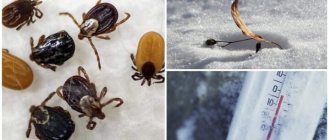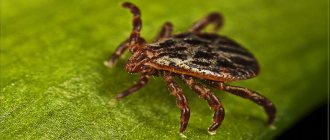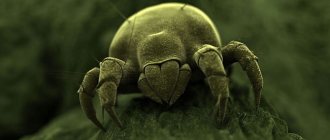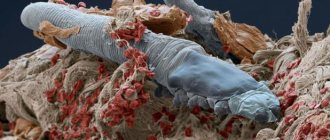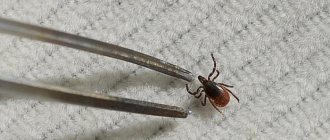The time for tick activity started in 2021 a month ahead of schedule . In the first ten days of March, single bites were recorded. And although they did not cause infections, the danger of the spread of parasites remains. Experts attribute the earlier appearance of insects to warm temperatures in the last winter month. The first attack of 2021 was recorded on March 7.
In February, temperatures above 5°C were observed for several days. This was enough to awaken the parasites. Insects are not afraid of the cold, so they did not adhere to the activity schedule, the apogee of which traditionally falls in May.
Not all individuals are dangerous to people. The sources of encephalitis infection are two types - Persulcatus and Ricinus. To avoid getting infected, you should take safety precautions in advance. In particularly dangerous areas, vaccination against viral encephalitis is effective. The vaccination is effective even after a bloodsucker bite.
Spring time is especially comfortable for parasites. In summer they go hunting only early in the morning or late in the evening. The scorching sun, low humidity and heat are not suitable for bloodsuckers. Insects are looking for shade and freshness, so meeting them in the lowlands and on forest paths is inevitable.
The active season for ticks falls at the end of spring - beginning of summer. By the end of June, the supply of nutrients in the body of bloodsuckers begins to deplete, and this leads to their death. By mid-summer the number of ticks becomes smaller, and by the end of summer it decreases even more.
Vaccination against viral encephalitis is recommended one and a half months before the start of the bloodsucking season - before potential contact with a tick.
Time of appearance of ticks
The season of parasitic insects begins in early spring and ends in autumn. Saluberogenic conditions for the life cycle of insects are an air temperature of +20°C and a maximum humidity of 80%. In such an environment, they awaken faster from winter sleep.
Official information from the Rospotrebnadzor website.
The beautiful time associated with the flowering of snowdrops and swelling of the buds is also comfortable for insects that carry encephalitis. They begin to wake up already at a temperature of +1°C, but “come out” at 10°C, when the snow melts and the air warms up. Parasites like sunny days and calm weather. Insects hide in tall plants.
It is impossible to determine the exact time of awakening. This happens at different times every year. The activation process depends on climatic conditions. Were the winter months harsh? This means that the ticks will be passive.
Life cycle specifics
After fertilization, females spend the winter in burrows and lay eggs after waking up. Therefore, in spring their numbers are especially high. The life cycle of the parasite lasts 2 years. During this time, three owners change.
After birth, the larvae look for a food source - a warm-blooded living creature. They can be wild animals, birds, rodents. After drinking a sufficient amount of blood, the insects fall off, molt and transform into nymphs. This happens already at the end of summer - at the beginning of autumn.
The next owner of the nymphs can be not only an animal, but also a person. After saturation, the nymph falls off again and turns into an adult. This happens before winter. The parasite goes into hibernation.
The next development cycle begins in the spring of next year. Bloodsuckers become females and males, drink blood again and reach the breeding season. Afterwards, eggs are laid.
When are ticks especially dangerous?
Contact with a tick is always unpleasant. But at certain times it simply cannot be avoided. The life cycle affects the period of parasite activity. This time usually falls in May and June. Warm air and infrequent precipitation are most suitable for parasitic bloodsuckers. During short-term rain, they do not even rush to shelter, continuing to look for a new victim.
After June the danger decreases. This is due to the following factors:
- ticks are eaten by other representatives of the animal world;
- females that have laid eggs and completed the life cycle die;
- decrease in humidity and increase in temperature.
The season of tick activity ends when cold weather sets in. When the first frosts are recorded in September, parasitic insects will begin to hide and will not emerge from their shelters until spring. If the autumn turns out to be warm, it may be preferable for individuals to disappear in the second or third month of autumn.
The second generation of parasitic insects appears at the end of summer, but they are not as ubiquitous as in the spring. The main thing for them is to get enough and continue the development cycle.
The table shows the activity of ticks according to calendar cycles:
| Period | Activity level |
| March, April | Reduced |
| May June | Increased |
| July August | Average level |
| September October | Low |
Ticks are active around the clock. The attack occurs through prolonged contact with grass, bushes or other vegetation.
Danger to humans
The fact that the pest drinks blood is not scary. Parasites are active distributors of many serious infections and diseases:
- theileriosis;
- erpichiosis;
- Lyme disease;
- fever;
- tick paralysis;
- hematozoonosis.
In cats and dogs, parasite bites can cause tularemia. Only dogs can become infected with piroplasmosis. And encephalitis deserves special mention. This is a serious disease that is difficult to diagnose and treat.
The consequences of a tick bite are associated with unpleasant sensations on the skin. Red spots appear and blisters remain. An allergic reaction may occur. If infection does not occur, the described signs will disappear on their own after 6-7 days. If the virus gets into the blood, the development of the disease may begin. The incubation period ranges from two days to two months.
Ixodid ticks cause great danger. Insects retain the virus in the blood, pass it on through generations, and do not get sick themselves.
This season, ticks are showing unprecedented activity. What do you need to know to avoid danger?
Floods are not the only problem that Russian residents face in the spring. Every year, along with the first greenery, ticks wake up. According to Rospotrebnadzor, the number of victims of bites has quadrupled. Over 30 thousand people have already contacted doctors, nine thousand of them are children.
How to properly remove a tick? Video instructions, of which there are plenty on the Internet, are relevant in every spring season.
With the arrival of warmer weather, such a video can be recorded in almost any region of Russia. The places where ticks are most active are highlighted in red on the map - the belt from Kaliningrad to Sakhalin.
In Krasnoyarsk, the tick season began earlier than usual this year. The first encounters between humans and dangerous arthropods began to be recorded back in March.
Now you can pick up a tick even within the city. The slope, where residential areas are just a stone's throw away, is one of many centers of their spread. It is not recommended to walk here at all, or, if you have already gone out, at least take precautions. Closed clothing, high shoes. Boots are best, but if you don't have them, you can just tuck your pant legs into your socks. It looks ridiculous, of course, but it’s safer.
Experienced tourist Konstantin Nagovitsyn from Kemerovo with ticks, as they say, is on you.
“The tick crawls up, it doesn’t crawl down, and in any case you will find it on clothing,” he explains.
Sometimes you don’t even need to go into the forest. Three-year-old Dasha from the Novosibirsk region was attacked by a tick right in the yard.
“We were walking on the site near the house, and the next day we found a tick in our head,” says Kristina Logacheva.
Immunoglobulin injections, then long therapy under the close supervision of doctors. Fortunately, the infection passed by. As doctors say, detecting encephalitis or the equally terrible Lyme disease in the human body is much more difficult than in carriers.
“The tick must be checked, even when they come to us with symptoms, we ask whether the tick was checked or not, because this is very important for us for diagnosis,” notes the acting director. Head of the department (Novosibirsk) Anna Ovchinnikova.
During the peak of the dangerous season, queues form to submit ticks for analysis. But all traditional test systems are either not entirely accurate or take too long when the clock is ticking.
“Whether the patient needs to be given an injection of serum immunoglobulin - specific against the tick-borne encephalitis virus, or not, this decision must be made literally on the very first day,” explains Nina Tikunova, head of the laboratory of molecular microbiology at the Institute of Chemical Biology and Fundamental Medicine of the SB RAS.
Scientists from Novosibirsk and Krasnoyarsk have developed a system that can detect encephalitis in a tick in literally a matter of minutes.
In the substance they created, some molecules cling to the virus, while others emit a light signal.
“This year we will continue our work, as a new season begins, and we expect to develop clear criteria and confirm our method for identifying this virus,” says Lyudmila Frank, leading researcher at the Institute of Biophysics SB RAS.
The effectiveness of the method was confirmed by tests. The technique allows you to test up to hundreds of mites in a short time. The first experimental subjects are already there. A peak in activity is expected in the coming weeks. Residents of the regions most loved by ticks are advised to spend less time in nature.
Causes of tick activity
Ixodid ticks, which are most dangerous to humans, feel more comfortable in tropical climates. Under such conditions, one life form quickly transforms into another. The cycle may last a year or less. Our country has a more temperate climate, so ticks live here for two years. Paradoxical as it may seem, negative temperatures increase the life of an insect. Therefore, Siberia is considered the most dangerous region in terms of tick habitat.
The fundamental factors of parasite activity are not only temperature and humidity. Its surge is also influenced by the length of day and night in the daily cycle. The change in phases causes a response in the bloodsuckers. Reproductive activity increases or decreases. Therefore, each area has its own populations of ticks, which over the years have been able to adapt to the natural conditions of a particular region. Their behavioral reactions were steadily formed, and this led to periods of insect activity.
Hibernation
In mid-autumn, the second peak of tick activity ends, and by November they finally disappear, going into winter diapause. A decrease in temperature and a decrease in daylight hours are incentives for them to search for wintering places. Although parasites are resistant to frost down to -25°, they can only withstand it for a short time.
It is also useful to read: Ear mites in cats
During experiments, the most common dog ticks (Ixodes ricinus) and taiga ticks (Ixodes persulcatus) in Russia survived at a temperature of -10 ° for about 7 days, and when it dropped to -15 ° they died after three days. Hungry parasites can withstand more severe cold than well-fed ones, and eggs are the worst at surviving frost.
If the tick does not have time to hide, then in severe frosts it quickly dies.
This is interesting
There is a concept of hypothermia point - if the temperature drops below this value, then ice forms in the parasite’s body and the bloodsucker dies. Depending on the type of tick, the stage of its development and the degree of satiety, it ranges from -6 ° to -28 °.
To winter, the tick needs to find a windproof place where the temperature will not drop below -6 ° even in the most severe frosts. Therefore, parasites burrow into the forest floor, climb into soil voids or rodent holes.
On a note
Even in winter, the danger of a bloodsucker attack remains. Ticks can enter people's homes and agricultural buildings along with grass and emerge from hibernation due to heat. But you shouldn’t be afraid to bring a parasite into your home along with the New Year tree. Ticks do not climb trees, and the cracks in the bark are too small for reliable winter shelter.
Relevance of vaccination
Timely vaccinations will help to avoid many troubles associated with pest bites. You just need to do this a month and a half before the onset of the active season (from mid-January to early February).
In Siberia, the issue of vaccination is kept under special control. Mass diseases are recorded here quite often. Vaccination is not just a relevant procedure, but in some cases even mandatory. If you plan to travel to Siberia, you must be vaccinated against encephalitis. It is carried out in three stages with an interval of one calendar month. Vaccination is carried out in health centers in all regions of the country.
There is no vaccine for some diseases, such as borreliosis. Therefore, it is necessary to protect yourself from parasites in any case, even if you participated in vaccination. Repellents and thick clothing will help. When hiking in the forest, the most closed clothing is required. After returning, clothes must be washed thoroughly.
Note!
When a tick comes into contact with an open area of skin, it is not absorbed immediately, but after a couple of hours. Be careful: you can simply shake the insect off.
Tick activity in regions
Some insects of the same species lead an ambiguous lifestyle in natural areas that differ in climate.
The spring outbreak of parasitic insects in the Moscow region is observed at the beginning of the second spring month and lasts until the middle of the first summer month. Most often, bites are recorded in early May. The duration of the period is 2 weeks. The calm phase begins in the middle of the first summer month. Resumption begins on the 15th of August.
Winter behavioral diapause of parasites occurs in Moscow in mid-October. The end of the activity phase occurs in the first ten days of April.
Two dynamics of seasonal activity are characteristic of temperate climates. In adult parasites, a pair of behavioral diapauses alternate—winter and summer.
In the Arctic, bloodsuckers attack in June-July.
In the southern districts of Russia, tick activity lasts from the first ten days of March to the second ten days of November. In hot regions, summer diapause lasts longer.
In regions where precipitation is scarce, mites concentrate in plant roots. During the period of activity, the parasites attack weakly. In such a climate, bloodsuckers are active from March to May and from September to November.
At northern latitudes the climate is cold, so there is no summer diapause in parasitic individuals. The maximum number of recorded attacks here is recorded in the first and last weeks of summer.
Effective ways to control ticks
To protect the local area or outdoor recreation area, you can use smoke bombs and preparations for spraying plants based on insectoacaricides.
Mass destruction of ticks is prohibited, as this may affect the cycle of nature. Representatives of the fauna feed on ticks. However, local treatment is often the only effective remedy. Hiring professional exterminators will help protect the area around your home or other area.
During treatments, effective drugs with an increased safety class are used. Exterminators are only dangerous for ticks and do not cause poisoning to humans or pets.
The bite can be avoided
To do this, you should use special repellents with permethrin - they will repel ticks. It is enough to spray them on clothes and shoes, avoiding contact with skin or food.
Also avoid places where these parasites accumulate: dense thickets, tall grass and impenetrable undergrowth. Try to stay on the path. Coming from nature, you should not bring fresh flowers into the house, check your clothes and pets for parasites.

